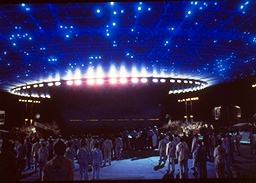

USA science fiction
1977
color 135 min.
Director: Steven Spielberg
CAV: $124.95 - available
3 discs, catalog # CC1241L
CLV: $59.95 - available
2 discs, catalog # CC1242L

For
a twenty-seven-year-old director with a smattering of television experience and
only one prior feature, Steven Spielberg demonstrated an awesome mastery of the
film medium when his first big production hit the screen in 1975. An instant and
certifiable phenomenon, Jaws had vicarious thrill-seekers queuing up
around city blocks all over the world and within months became the biggest
grossing film in history. Could the audacious Spielberg make lightning strike
twice, or was his shark picture merely a fluke? Not even he could say for sure.
One thing was certain, however, Jaws would afford its young creator a rare
opportunity to write his own ticket -- at least for one more outing -- and
Spielberg was determined to make the most of it.For years, Spielberg had been
fascinated by accounts of unidentified flying objects. As a youth, he had been
introduced to the wonders of the heavens by his father. At sixteen he parlayed
that interest into a two-and-a-half-hour 8mm movie about scientists investigating
strange lights in the sky. Some years later, he wrote an unpublished short story
on a similar theme and at one point intended to launch a low-budget UFO film
immediately after his first feature, Sugarland Express. Then Jaws
-- still a novel in galley form -- came to his attention, and Spielberg's
winning campaign to claim the film adaptation for his own completely altered the
course of his career. The UFO project was set aside. Even so, during idle,
waterlogged moments in the making of Jaws, Spielberg and actor Richard
Dreyfuss would toss about ideas for an epic film chronicling mankind's first
full-blown contact with beings from another world.
With a green light from
Columbia Pictures to develop the big-budget project, Spielberg commissioned a
script from screenwriter Paul Schrader. Unhappy with the results, the director
decided he could do a better job himself and over the next two years wrote half a
dozen drafts on his own. Central to his vision were two concepts all but alien to
science fiction films. Virtually without exception, extraterrestrial contact as
depicted in motion pictures had been of a strictly hostile nature. Spielberg felt
that any alien race capable of interstellar travel would be more altruistic in
its motives. Indeed, there was little in the literature of UFO sightings to
suggest otherwise. Also, he was determined not to tell his story through the
studied empiricism of learned scientists -- another cornerstone of the genre --
but through the wide-eyed emotionalism of an ordinary blue collar worker whose
life is cast into dizzying disarray as he struggles to cope with the
unknown.
With a title derived from the terminology employed by those who
observe and investigate unidentified flying objects, Close Encounters of the
Third Kind went into production at Devil's Tower National Monument in Wyoming
and then relocated to Mobile, Alabama where a giant dirigible hangar was
transformed into the largest indoor set in motion picture history. Later, there
would be location sequences shot in India and the Mojave Desert. But it was the
UFOs and their inhabitants that would consume the greatest amount of time and
energy. A full year-and-a-half would be needed to complete the optical and
miniature work.
Douglas Trumbull, engaged as visual effects supervisor for the
production, was as much a wunderkind in his own field as Spielberg was in his.
Employing newly developed technology to create precisely repeatable camera and
model movements, Trumbull and his Future General organization managed to simulate
on film the kinds of sightings commonly reported by UFO observers -- brilliant,
multicolored shapes of light capable of speeds and aerial maneuvers beyond the
realm of human technology.
Building to a grand finale in which a gigantic
mothership and its cosmic voyagers are revealed to a select group of observers at
the Devil's Tower site, Close Encounters electrified audiences around the
globe. Within days of its 1977 release, it was apparent that, for Steven
Spielberg, lightning could indeed strike twice -- and had. But the film still
fell short of the one he had sought to make. Time and money had imposed limits on
his aspirations.
Two years later he was able to fulfill his original vision. In
a move unprecedented for a film already released to popular and critical acclaim,
Spielberg excised sixteen minutes from his original cut and replaced it with
seven minutes of previously deleted footage and six minutes of new material
generated specifically for a "Special Edition" reissue. It is this revised
version of the film -- highlighted by a breathtaking look inside the alien
mothership -- that has predominated in the years since its unveiling, and it is
this version only which has been available to the home video market. For years
film buffs have debated which one is the "best." Now home video viewers will have
the chance to decide for themselves, with The Criterion Collection offering the
definitive presentation of Close Encounters of the Third Kind -- complete
and intact as originally released and supplemented with the "Special Edition"
material which can be viewed either separately or in proper sequence within the
film.
-- DON SHAY
Credits
Director: Steven
Spielberg
Produced by: Julia and Michael Phillips
Screenplay: Steven
Spielberg
Music by: John Williams
Director of Photography: Vilmos Zsigmond
A.S.C.
Visual Effects: Douglas Trumbull
Director of
Photography-Photographic Effects: Richard Yuricich
Edited by: Michael Kahn
A.C.E.
Supervising Sound Effects Editor: Frank Warner
Production Designer:
Joe Alves
Set Decoration: Phil Abramson
Art Director: Dan
Lomino
Wardrobe Supervisor: Jim Linn
Chief Model Maker: Gregory
Jein
Special Edition Effects: Robert Swarthe
Transfer
This
edition of Close Encounters of the Third Kind was transferred digitally
from three sources, an interpositive, a CRI (color reversal internegative), and a
camera negative, all in the correct aspect ratio of 2.35:1. The soundtrack was
mastered from a 35mm magnetic track.





